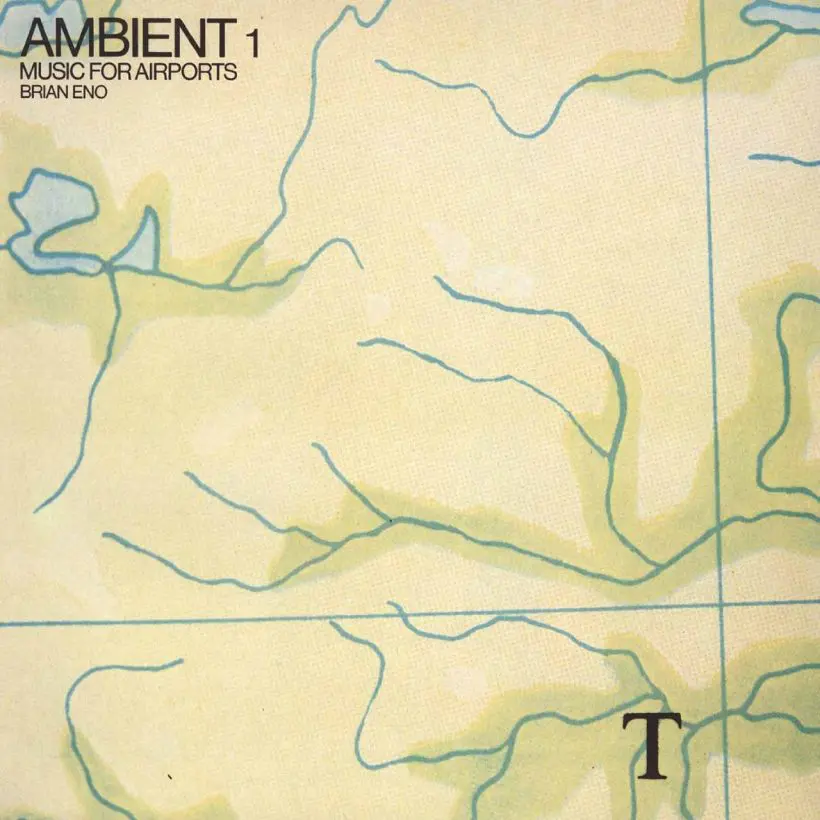‘Music For Airports’: Brian Eno’s Ambient Music Classic
Through making a record ‘as ignorable as it is interesting,’ Eno created a new musical genre.

Brian Eno’s dalliance with minimal musical soundscapes can be traced back to the sound-on-sound tape loops he created in collaboration with Robert Fripp on 1973’s (No Pussyfooting). Yet, while that album and subsequent titles such as Discreet Music and the second half of Before And After Science leaned heavily towards the pastoral, Eno would only explicitly label the music he was creating “ambient” when he released his sixth album, Music For Airports in September 1978.
“Ambient music is intended to induce calm and a space to think,” Eno elaborated in the record’s liner notes. “It must be able to accommodate many levels of listening attention without enforcing one in particular. It must be as ignorable as it is interesting.”
Listen to Brian Eno’s Music for Airports now.
Though it only saw the light of day in the fall of 1978, much of Music For Airports’ content dated back to 1976, while Eno was working on David Bowie’s widely-acclaimed Low. He was initially inspired by the negative feelings aroused in him while he waited for a flight at a German airport – and he struck on the idea of recording some pleasantly neutral music designed to soothe the soul of an individual stuck in the limbo of an airport lounge.
The recording of Music For Airports
In an interview with the UK’s The Telegraph, Brian Eno later said he wanted Music For Airports to sound “like something [the listener] can slip in and out of.” To achieve this aim, he began by visiting Kraftwerk and Neu! producer Conny Plank’s studio in Cologne, where he asked the producer to record a series of single notes sung by a trio of German female singers.
Eno later manipulated these single notes by looping them via tape machines. He also gathered up further material during an improvised session back in England featuring guitarist Fred Frith (formerly of 70s cult band Henry Cow) and Robert Wyatt – one of the founding members of acclaimed jazz-rock outfit Soft Machine – playing piano. Eno also turned this spontaneous material into tape loops which could be set in motion simultaneously to create cycles of repeating notes and phrases.
Having turned this source material into something quite otherworldly, Eno broke it down into individual tracks for Music For Airports. In keeping with the idea that the content should be as neutral as possible, Eno eschewed the standard route of creating song titles and names the pieces “1/1”, “2/1” and “1/2.” The opening track “1/1” was dominated by the arrhythmic piano loops – though it did feature the record’s most distinctive melody – while “2/1” and “1/2” primarily made use of the vocal loops Eno had recorded at Conny Plank’s studio.
Describing the recording of Music For Airports at the Imagination Conference in San Francisco in June 1996, Eno elaborated further on the studio techniques he had employed.
“There were twenty-two loops,” he said. “One loop had just one piano note on it. Another would have 2 piano notes. Another one would have a group of girls singing one note, sustaining it for 10 seconds. There are 8 loops of girls’ voices and about 14 loops of piano.
“I just set all of these loops running and let them configure in whichever way they wanted to. And in fact, the result is very, very nice. The interesting thing is that it doesn’t sound at all mechanical or mathematical as you would imagine. It sounds like the guy is sitting there playing the piano with quite intense feeling. The spacing and dynamics sound very well organized. That was an example of hardly interfering at all.”
Indeed, the only Music For Airports piece Eno himself performed on in any kind of traditional manner was the closing track, “2/2.” This piece featured Eno on an ARP 2600 synthesizer: a versatile analog instrument that also features prominently on 1970s classics ranging from David Essex’s “Gonna Make You A Star” to Elton John’s “Funeral For A Friend.”
“[The instrument has] a beautiful sound, I think,” he said in a 1981 interview with Keyboard Wizards magazine. “It’s a sound that I couldn’t have gotten from any other synthesizer that I know of. The thing that makes it so luscious is that it’s slowed down – and it has three kinds of echo on it.”
The legacy of Music For Airports
While Brian Eno firmly believed that passages from Music For Airports were “beautiful,” the critics of the day were less inclined to buy into the record’s super-minimal approach. Rolling Stone felt it was “self-indulgent and lacking focus” and while The Village Voice’s Robert Christgau suggested its “four swatches of modestly ‘ambient’ minimalism” had “real charms as general-purpose calmatives,” he also dubbed the record “a bore.” Lester Bangs was a little more upbeat in Musician magazine, declaring Music For Airports had “a crystalline, sun-light-through-windowpane quality that makes it somewhat mesmerizing, even as you half-listen to it.”
Yet, as with any such innovative artistic statement, Music For Airports’ reputation has grown substantially with the passing of time. Indeed, in more recent years, Eno’s quiet masterpiece has been recognized as the ground-breaking and influential release it surely is, with Pitchfork naming it the ‘Best Ambient Album of All Time’ in 2016 and a reappraisal in The Washington Post proclaiming that it “taught an entire generation of musicians to consider music as a texture.” For a record compiled with little thought given to its commercial yield, Music For Airports also had the last laugh, as it’s moved an estimated 200,000 copies, making it one of Brian Eno’s best-selling solo titles.
“It is a little like muzak, but it’s really beautiful too,” Eno said, reflecting on the album in an interview with Andy Warhol’s Interview magazine in 1978. “I didn’t go into it thinking I’m going to make a very interesting piece of music here. I went into it thinking I wanted to make something that would work in an airport that would actually make you think flying was a pleasant thing to do instead of an unbearably uncomfortable thing – as I think it generally is.”














